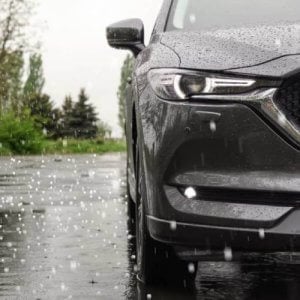Home / Compare Car Insurance / Car insurance for hail d…

Key takeaways
Australia’s weather can be unpredictable, and hail damage in particular can be a huge concern for car owners come storm season. If your car is caught in a hailstorm, your car insurance may be able to help with the repairs. Here are a few important things to keep in mind about hail damage cover in your car insurance:
- Only comprehensive car insurance can cover hail damage to your vehicle.
- Your cover for hail damage will come with conditions, like paying an excess to make a claim for the damage.
- If your car has pre-existing hail damage, your insurer won’t cover the repairs for this, and there may be further limitations if you need to make a claim for something else.
Expert tips on car insurance for hail damage
Compare the Market’s car insurance expert, Adrian Taylor, has these tips for car owners to help them navigate insurance for hail damage.

Disclose hail damage to your insurer
If your car is already hail-damaged, you should always disclose this to your insurer when taking out or renewing your policy. This information can be important to an insurer when assessing if they’ll provide cover and the premium you will need to pay.
Weigh up the cost of repairs against your excess
If your car is damaged by hail, consider the costs of the repairs against your policy’s excess before you invest time contacting your insurer and starting a claim. If the repairs are cheaper than your excess, you may still contact your insurer to lodge a claim, however but it might be less economical to complete the repairs this way.
Keep up to date with weather alerts
Avoid hail damage in the first place by heeding any hail alerts sent by your insurer or weather authority. You can also sign up for weather alerts on various sites. Park your car safely away from the elements whenever possible.
Insurance for hail-damaged cars
Does car insurance cover hail damage?
 Car insurance can cover your car if it’s damaged by a hail storm, provided that you have the right type of policy. You’ll need comprehensive car insurance cover (the broadest level of car insurance available) to cover hail damage.
Car insurance can cover your car if it’s damaged by a hail storm, provided that you have the right type of policy. You’ll need comprehensive car insurance cover (the broadest level of car insurance available) to cover hail damage.
A comprehensive policy will also cover you for many other weather-related damages caused by fires, storms and floods, and some policies may also provide roadside assistance as an optional extra.
Can I insure a car with pre-existing hail damage?
Hail damage can be covered by insurance providing there isn’t too much pre-existing damage to the car. Some insurers can be reluctant to cover cars heavily damaged by hail already as it can be hard to ascertain any recent damage to the panel work claimed from the existing hail damage.
Typically, insurers may exercise one of three following options for covering a pre-existing hail-damaged vehicle:
- They may refuse to cover your vehicle altogether – based on the pre-existing damage
- They may offer you only reduced cover options (i.e. Third Party Fire and Theft)
- They may offer comprehensive cover excluding pre-existing damage (subject to insurers underwriting conditions as per the risk).
In some cases, and depending on the damage, insurers may offer you a market value policy for your hail-damaged car. However, even if your policy does cover your already hail-damaged car, it doesn’t always mean your car will be repaired. If the cost of repairs is more than the car is worth, insurers may offer a cash settlement instead.
Make sure that if you do have any pre-existing hail damage on your vehicle at the point of taking out a policy, you inform your insurer. It is your responsibility to provide this information to your provider otherwise they may void any claims made thereafter.
How car insurance for hail damage works
Do I need to pay excess for hail damage?
You’ll usually pay an excess when claiming for hail damage, which will be the amount you chose when you took up or last renewed the policy. As a general rule, the more money you agree upon as your up-front excess, the less your insurance premiums will be, and vice versa.
Are there cases where I won’t be covered for hail damage?
There are often exclusions associated with taking out a comprehensive car insurance policy, which may apply to a hail-damaged car. For example, if you fail to disclose your car’s pre-existing accident damage when you took out the policy, this may impact the outcome of a car insurance claim.
As exclusions can vary between policies and insurance providers, it pays to read over the relevant Product Disclosure Statement (PDS) for a list of exclusions to your cover, as well as the Target Market Determination (TMD) to determine if the policy is suitable for you.
Important to know
Is it legal to drive a hail-damaged car?
 You may still be able to drive your car with storm damage or hail damage, but only if it’s safe to do so. Purely cosmetic damage shouldn’t force your vehicle off the road. Still, regardless of any dents, a car may be deemed defective and unroadworthy if:
You may still be able to drive your car with storm damage or hail damage, but only if it’s safe to do so. Purely cosmetic damage shouldn’t force your vehicle off the road. Still, regardless of any dents, a car may be deemed defective and unroadworthy if:
- The windows are cracked or damaged
- Windscreen wipers are damaged or broken
- Indicators, taillights or headlights are destroyed.
The car can usually be driven again once these issues are fixed, but until they are, it could be deemed unroadworthy and an offence to operate on the road. If a car is considered a statutory write-off or total loss due to severe damage, it could be deemed unroadworthy forever. However, a repairable or economical write-off may eventually be re-registered and driven again provided it passes vehicle safety and identity checks in your state or territory.
How else can you protect your car against hail damage?
While comprehensive insurance may take care of the financial fallout of a hailstorm, there are other ways to protect your vehicle in the first place, such as:
- Knowing the weather forecast. If hailstorms are predicted, try rescheduling your car journey to avoid damage. If a severe weather event is expected, some insurers will alert their customers ahead of time so that they can seek shelter for their cars or make alternative arrangements.
- Seeking shelter and safety. If in danger, find a place where it’s safe to pull over, ideally a covered area. However, avoid parking under trees or in areas prone to flooding in extreme weather; this could damage your car in other ways. Instead, opt for garages, car parks or secure shelters. Never speed to try and beat a storm or park somewhere that can cause you or others harm.
- Purchasing a hail protector tarp. Protective hail tarps offer extra padding and protection and may be an option.
Meet our car insurance expert, Adrian Taylor
As a General Insurance expert with over 13 years’ experience in financial services, Adrian Taylor is passionate about demystifying car insurance for consumers, so they have a better understanding of what they’re covered for. Adrian’s goal is to make more information available from more insurers, to make it easier to compare and save.


